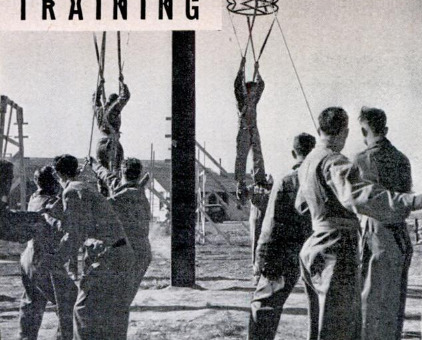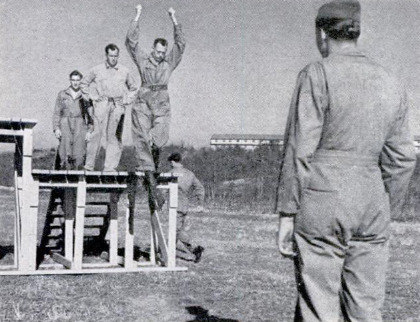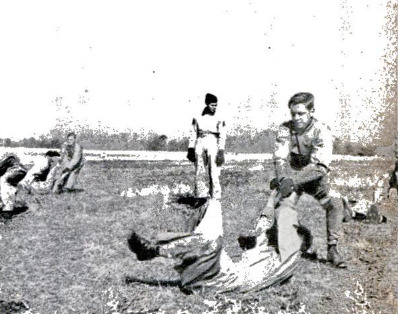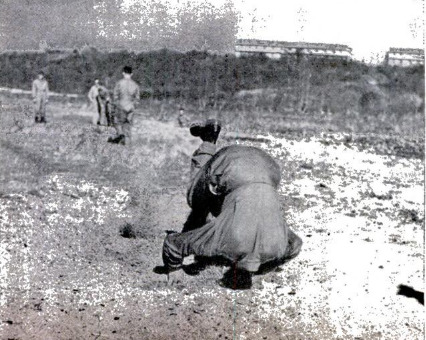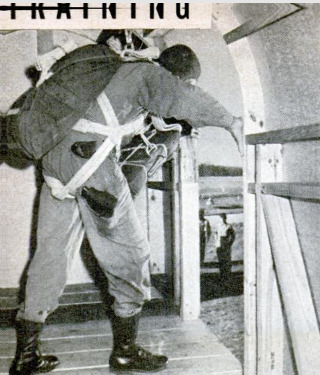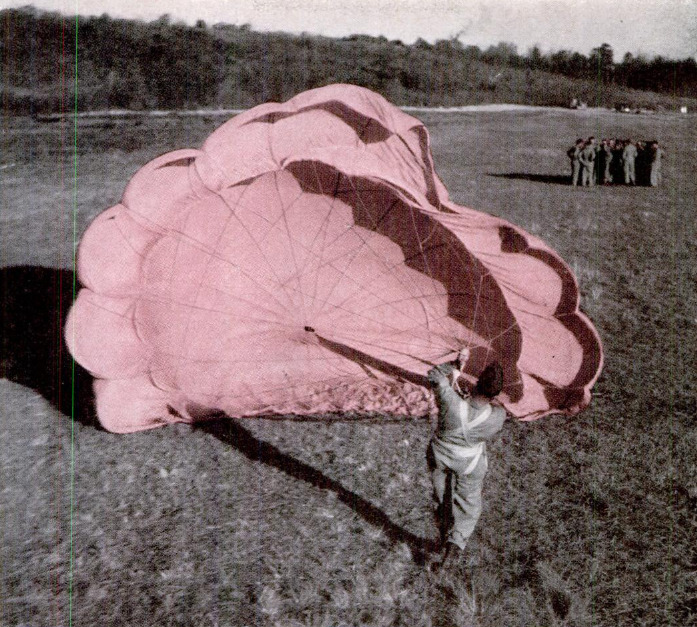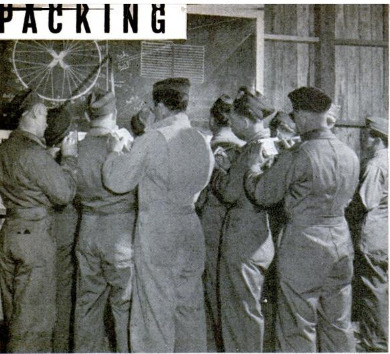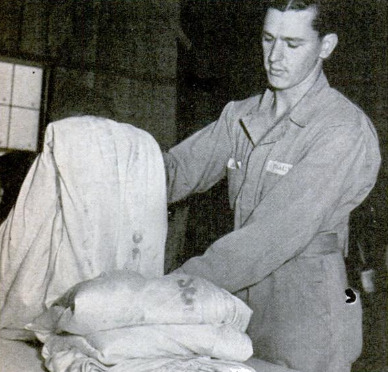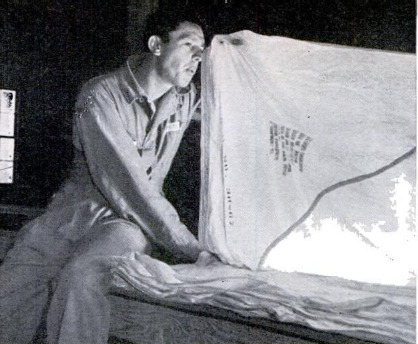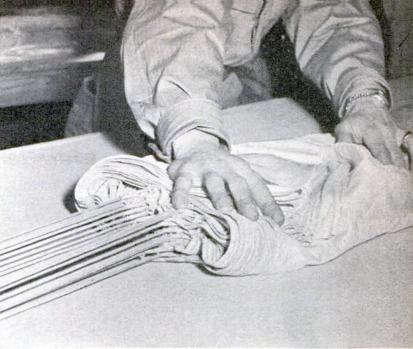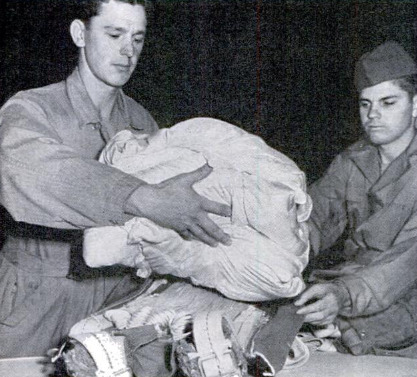-
Title (Dublin Core)
-
School for sky soldiers
-
Article Title and/or Image Caption (Dublin Core)
-
Title: School for sky soldiers
-
extracted text (Extract Text)
-
Tz parachute troops of the Army and
Marine Corps are tough outfits. Only
outstanding men with at least a year's ex-
perience in uniform are picked and they are
toughened scientifically, They are hard-
boiled “canopy” jugglers by the time they
are assigned to a parachute battalion.
Ground and lofty tumbling is their meat
from the moment they are accepted for the
service, for which the number of volunteers
far exceeds the rate of acceptance. They
must be muscular and intelligent and gifted
with initiative, and nobody weighing more
than 185 pounds is accepted. By the time
they are ready for service any one of them
probably could throw over his shoulder the
Siamese tumbler who made the first record-
ed parachute jump from a pagoda in 1687.
Starting with drops of six or eight feet
to get used to the jolt of landing, they
progress by way of the tower-guided para-
chute to jumps from planes, and all the time
they are being hardened for wrestling
matches with recalcitrant, gust-driven
‘chutes and for the exacting field service for
which a ‘chute jump is merely the prelimi-
nary. They must be capable of a good many
miles a day afoot, running a good portion of
it. A ’chute soldier seldom is seen walking
while on duty; he executes all orders at
double time.
The parachute troops have gone back to
the old static-line ’chute, which has a strong
cord attached to the plane, because of the
special conditions of their work. A static-
line 'chute permits drops as low as 100 feet
above the ground, and in war that means
less time for enemy “parashots,” or sporting
old gentlemen with shotguns, to pot the
parachutist.
Our Army and Marines are not planning
to put the troopers through any 100-foot
jumps in training or maneuvers, but it is to
prepare for low jumps, as well as leaps in
choppy air and high winds, that they are
taught tumbling. All their exercise is di-
rected toward strengthening their shoulders,
arms, and leg muscles, and to make it
second nature for them to land relaxed, on
their toes, sink onto their knees, and twist
quickly so that they will hit on the soft part
of the body.
In normal air a parachute drops at about
the same rate of speed as a skyscraper ele-
vator, though unlike the elevator it does not
slow up before stopping. If the air is choppy
it may fall nearly twice as fast as normally.
Normal is 16 to 18 feet a second, with the
life-saving ‘chute, which has a spread of
24 feet. The parachute Lroops, however,
use 28-foot chutes, which let a 180-pound
man down at the rate of 12 feet a second.
This permits a man to carry more equip-
ment than does a flyer bailing out of a
disabled plane.
Under war conditions, when there may be
no choice of weather or terrain, they'll need
slow parachutes. Even in a moderate wind,
a parachutist often lands going faster side-
ways than he is falling, which is pretty
tough if he tumbles on rocks or concrete.
A story current among U. S. Army para-
chutists is that the Germans lost 47 percent
of their air troops at Narvik, by dropping
them too low and on sharp rocks.
The German parachute trooper cannot
maneuver his ’chute, for all the suspension
lines come in at one point and he hangs
below that like a monkey on a string, unable
to reach them. The 24 lines on the American
life-saving 'chute and the 28 on the trooper’s
larger ‘chute are gathered at four points of
suspension on the harness, two on each
shoulder. By grabbing the six or seven lineswhich come in at one point, and pulling
them down a yard or so, the ’chutist can
slip or “fall off” in that direction, and thus
avoid falling into a tree or water hazard.
Men accepted for training as parachute
troopers must have “demonstrated soldierly
qualities, agility, athletic ability, intel-
ligence, initiative, determination, and dar-
ing,” and be able to learn map reading,
sketching, radio, and demolition. They must
be expert with their weapons, unmarried,
and not more than 32 years of age. They
are turned down if heart action or blood
pressure is even slightly off normal, or if
they are subject to airsickness. The men
receive additional pay, which is 50 percent
more than what their regular ratings draw.
On arriving at the training station, Pete,
as we will call our typical parachutist, is
issued, in addition to his regular uniform, a
suit of khaki coveralls, with a belted back
and pleated shoulders, to afford maximum
freedom of movement. At the wrists and
ankles are adjustable bands, with buttons
so they can be fastened snugly. His 14-inch,
laced leather boots have an ankle brace built
in, to be tightened before he jumps. Every-
thing a parachutist carries in his pockets
must be well fastened in: a jump amounts
to about the same thing as being picked up
by the heels and shaken, none too gently.
Pete's first lesson is in nomenclature. He
learns that the big silk umbrella itself is
called the canopy, and that although it
weighs only 1.35 ounces to the square yard,
it has a tensile strength of 40 pounds to the
inch, and a minimum tear strength of 41%
pounds. A 24-foot canopy is made up of
96 pieces of silk twill, sewn with four
needles. A 28-foot 'chute contains 112 pieces.
Four pieces, or panels, are sewn to form a
gore, a narrow, pie-cut piece which is a yard
wide at the edge of the canopy, and tapers
down to less than two inches at the center.
There is an 18-inch hole in the center of
the canopy, called the vent, with a rubber
garter sewn inside its edge so that as the
‘chute starts to open the hole is only four
inches across. Air pressure usually expands
the vent to its full 18-inch diameter, and
air escaping through this hole, of course,
allows the ’chute to fall. But in strong up-
drafts, a parachutist may actually go up-
ward, until he spills wind.
Above the vent is a 36-inch pilot ’chute.
A steel spring makes it open first, at least
in theory, and it helps pull the big ’chute
open.
Leading from the vent, down through tape
between the gores, then out in the clear for
16 feet more, to four points on the shoulder
harness, are the suspension lines. These are
of silk, too.
After the lesson in nomenclature, Pete
takes the first of a number of lessons in
inspecting and packing a ’chute. Every
parachute trooper must inspect, air out, and
pack his own ‘chute every 30 days.
Most of the 412 men of the Army's first
unit, the 501st Parachute Battalion, spent
six weeks learning to pack their ’chutes,
practicing ground tumbling, and jumping
off low platforms to get the hang of landing.
The first real jump, however, was from a
plane. Now, with the building of steel train-
ing towers—similar to the parachute jump
at the New York World's Fair—the men
will begin jumping from the tower as soon
as they learn how to land. The pioneer
Marine ’'chutists have been using a tower
at Hightstown, N. J.
AT FIRST, wires guide the ‘chute straight
down, although the trooper wears rog- |
ulation harness instead of sitting in a swing +
seat checked by springs, as Visitors did in |
the World's Fair jump. ‘After two or three 1
“captive” jumps, Pete starts making “fly
away" jumps {rom the tower. |
The novice Is now taught to grab the
risers, webbing attached directly to the sus- |
pension lines, and twist his body so hell |
face down wind, Otherwise, in landing, the |
“chute ia likely to pull him over backward. 1
He i8 also taught to pull up on the risers
Just before landing to cushion his fall. The
Jar Is equal to a Jump from a 41% to six-foot
fence.
Before ho ever jumps from a plane he |
must also learn how to collapse his ‘chute |
after landing, by grabbing one or more sus- 1
‘pension lines and pulling it in fast until he
can catch hold of the canopy. He then sits |
down on as much of the canopy as he can
grab, and keeps on pulling it in. Even in
a 1‘mile wind, which ls just a breeze, n 1
fully inflated parachute will pull a man off
his feet and drag him.
In the Army, the Initial jump from a
plane is made with the static-line ‘chute, i
although the parachutist is taught to use
the rip-cord type as well. In all practice 1
Jumps Pete will wear two packs, the reserve
one being of the rip-cord type. Ho makes
his first jump at an altitude of at least
1500 feet in relatively still air. Before
stopping off into the blue, he and hi bud-
dies fasten static lines attached to thelr |
“chutes to a wire running along the side of |
tho plane, above their heads. His weight |
Jerks the “chute open, and the line breaks
away. I
Later he has to jump in a 35-mile wind,
and land in water, in a tree, and on top of
a building. Before landing in a high wind 1
or in the water, he must unsnap the harness |
around his legs and on his chest, then fold
his arms, to hold everything In place. As
his feet touch land or water he throws his
arms above his head, and the ‘chute is
blown free of him. He is taught to sideslip
away from trees or buildings, if possible.
When landing in a tree is unavoidable, he
must keep his legs tight together and kick
away from the tree, so that only the
canopy will get tangled in the branches.
The equipment of a parachute battalion,
made up of 34 officers and 412 enlisted men,
includes 386 pistols, 335 short-barreled auto-
matic rifles, or carbines; 30 sub-machine
guns, 27 .30-caliber machine guns, nine .60
caliber mortars, 30 folding bicycles, six au-
tomobiles, three motor cycles with side cars,
two half-ton trucks, and five 1-ton trucks.
Obviously a trooper cannot carry a .60
caliber mortar down with him. In actual
service he probably won't even carry a car-
bine, though the Army is experimenting
with the idea. A pistol, perhaps two or three
hand grenades, and a light silk rope for
letting himself down from a roof or tree
may be all Pete, the parachutist, will ever
take down with him.
Cargo "chutes will float carbines, machine
guns, mortars, and folding bicycles to the
ground. So troops will know which "chute
is which, the Army is experimenting with
red, blue, and yellow cargo canopies. The
Army is also experimenting with sky-blue
‘chutes and smoke bombs to screen para-
chutists.
Since it is essential that the parachutist
land as close to his equipment as pos-
sible, and also that, in many instances, a
number of men land fairly close together,
the Army flies transport planes as slow as
possible while the men are going over the
side. The pilot lets down the landing gear
and uses the landing flaps to slow up. Some
flights are even made with the plane doors
off, to break the streamlining.
Once the parachute soldier has landed
and picked up his equipment, he takes cover
and fights like any other infantryman. So
during the three months it takes to train a
regular infantryman as a parachutist, he
continues to practice digging in and taking
cover, as well as target shooting.
ENJAMIN FRANKLIN was the first to
B propose the use of parachute troops, in
1784. The Russians got their idea for air in-
fantrymen from experiments first conducted
by the U. S. Army nearly 20 years ago.
The U. S. Army organized its first para-
chute company only last summer after the
Nazi invasion of the Low Countries. The
air infantry’s work has progressed so well
that the force is being expanded to include
between 4,000 and 6,000 men. The Marines
also are expanding their parachute forces,
first organized last fall.
-
Contributor (Dublin Core)
-
Walter Holbrook (article writer)
-
Language (Dublin Core)
-
Eng
-
Date Issued (Dublin Core)
-
1941-04
-
pages (Bibliographic Ontology)
-
88-94
-
Rights (Dublin Core)
-
Public domain
-
Archived by (Dublin Core)
-
Sami Akbiyik
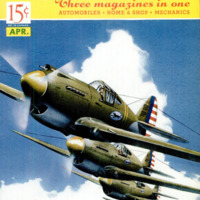 Popular Science Monthly, v. 138, n. 4, 1941
Popular Science Monthly, v. 138, n. 4, 1941
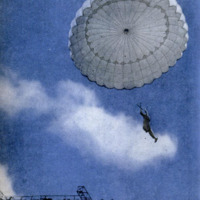 Screenshot_1.png
Screenshot_1.png Screenshot_2.png
Screenshot_2.png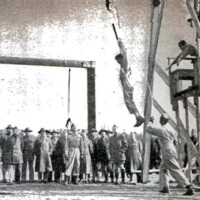 Screenshot_3.png
Screenshot_3.png Screenshot_4.png
Screenshot_4.png Screenshot_5.png
Screenshot_5.png Screenshot_6.png
Screenshot_6.png Screenshot_7.png
Screenshot_7.png Screenshot_8.png
Screenshot_8.png Screenshot_9.png
Screenshot_9.png Screenshot_10.png
Screenshot_10.png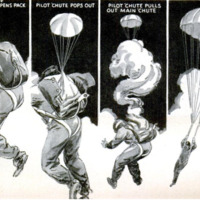 Screenshot_11.png
Screenshot_11.png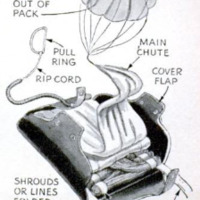 Screenshot_12.png
Screenshot_12.png Screenshot_13.png
Screenshot_13.png Screenshot_14.png
Screenshot_14.png Screenshot_15.png
Screenshot_15.png Screenshot_16.png
Screenshot_16.png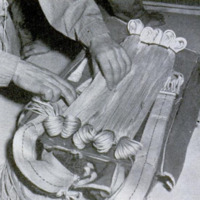 Screenshot_17.png
Screenshot_17.png Screenshot_18.png
Screenshot_18.png Screenshot_19.png
Screenshot_19.png Screenshot_20.png
Screenshot_20.png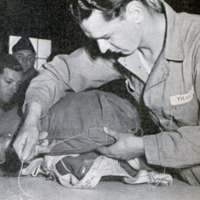 Screenshot_21.png
Screenshot_21.png

